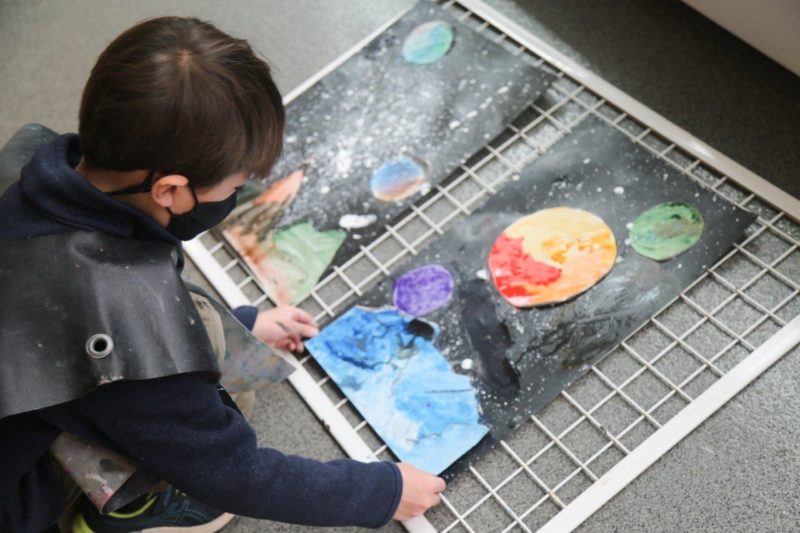I hope you are enjoying your summer and have taken the time to look up at the night skies and admire the moon and stars!
This sultry time of year is also the season for solar storms, when the magnetic shockwaves hitting Earth’s atmosphere fill the sky with the shimmering lights. During an intense flare, stargazers may even see the aurora borealis (also known as the Northern Lights) dancing in the skies over Connecticut. The Northern Lights are a dazzling reminder of the beauty and mystery of space, which was highlighted (and then some!) last week by the release of the first images from NASA’s Webb telescope. That remarkable instrument gave us spectacular views of distant galaxies from the beginning of cosmic time.
In light of all of the excitement about the Webb telescope, I thought you might like to revisit some of the information your children learned this past spring during a virtual visit with NASA Astronaut Don Pettit. Dr. Pettit spent 370 days on the international Space Station (ISS) and 13 hours space-walking, during which time he created a unique collection of photographs documenting the Earth, the universe and life on board the station. Currently the oldest active astronaut in the NASA program, his focus is now on Artemis, NASA’s next crewed mission to the moon.
Dr. Pettit is a marvelous speaker and teacher, and the way he communicated how awe-inspiring it is to go into space left the children spellbound. Interestingly, he said, the experience often brings out the artistic side in astronauts. At the same time, it requires an in-depth knowledge of science, math and engineering. For students who would like to be astronauts, he suggested the best way to start is to practice creating and fixing things with their hands. “You need to be able to build things, crawl under things and know how to fix them,” he explained. “Because if something breaks on the ISS, you have to repair it.” Dr. Pettit has put his technical skills to use not only on the ISS, but also on a six-week scientific expedition to Antarctica to search for meteorites, where he was called upon to make electrical repairs to a snowmobile and perform emergency dental surgery. “If any of you tinker and fix electronics,” he observed, “that hobby sets you up for excelling in space.”
Do astronauts conduct experiments on the ISS? “Yes!” was Dr. Pettit’s answer to the children’s great curiosity about life on board the space station. Since his background is in physics and chemistry, one phenomenon he studied was combustion. It turns out that a lump of charcoal burns at 2,000 degrees on Earth, but at half that temperature in microgravity—a discovery that has sparked a new field of inquiry called “cold combustion.” Dr. Pettit also investigated how liquids behave in weightlessness, and used his knowledge of fluid dynamics to make a coffee cup that works in microgravity so astronauts don’t have to sip their morning brew through a straw. His first cups on the ISS were made out of plastic report covers and duct tape! Fortunately, he has since refined that design, casting it in porcelain to make a zero-G coffee mug, which the children ooohed and aaahed at when he showed them his creation. In addition, astronauts perform experiments on themselves to learn how the human body responds to living in space. They discovered that the bacteria that live in the human body begin to express new and different areas of their genomes in space. To figure out what this means for astronauts on long missions, NASA is growing these bacteria over a long period of time to study the hidden genetics that emerge in microgravity.
Of course, no presentation by an astronaut is complete without a discussion of weightlessness. And Dr. Pettit did not disappoint when he described the fun of his work. “There’s nothing to hold you down, so you can fly around a room in space like Peter Pan. It takes a day or two to learn to fly. It’s one of the best parts of being in space: to float and fly.” And what happens when astronauts return to Earth’s gravity? It depends on one’s body type, he explained. Short, compact astronauts can pop out of the capsule and wobble around almost immediately, but tall, thin astronauts may need 24 hours to adjust. “It’s not a competition, though—you just work with your own body.”
During his time on the ISS, Dr. Pettit became one of the most prolific photographers in the history of space exploration. The space station orbits Earth at 4.76 miles per second—faster than a speeding bullet—so he had to invent techniques for taking sharp photographs with the camera technology available at the time. Lucky for us, Dr. Pettit has shared those striking photos with us in Spaceborne, a book that is a treasure trove of images of star trails, auroras and the stunning lights that embroider Earth at night. The exciting next chapter in space exploration, he said, will be to return to the moon and then travel beyond using Orion, a new ship that will carry humans farther into space than we have ever gone before.
With so many exciting developments to come in our understanding of space, Dr. Pettit promised to return next year to give the children an update. In the meantime, here’s to taking a moment to marvel at the night skies, tonight and every night …
Maureen

